Louisville Forecast 2015
Executive Vice Chancellor for Academic Affairs, Indiana University Southeast, New Albany
The Louisville metro area saw a deceleration of payrolls over 2014. Year-over-year growth almost hit negative territory in the middle of the year, but payroll has been on the upswing since. The Southern Indiana part of the region observed steady growth, with most of these job gains occurring in Clark County. While payroll gains did not materialize at the rate expected in last year’s Louisville outlook, the region did see additional declines in the unemployment rate. As 2014 came to a close, national payrolls were beginning to show additional gains, and the nation has now observed two back-to-back quarters of solid growth. We should expect to see continued payroll gains for the Louisville metro and Southern Indiana in 2015.
Louisville Metro Payrolls
The first quarter saw a decline in the nation’s gross domestic product (GDP), and this was felt locally through slower payroll growth. Stronger payroll growth resumed in the middle of the year as the nation exited the harsh winter (see Figure 1).
Figure 1: Louisville Metro Nonfarm Payroll Jobs, January 2000 to September 2014
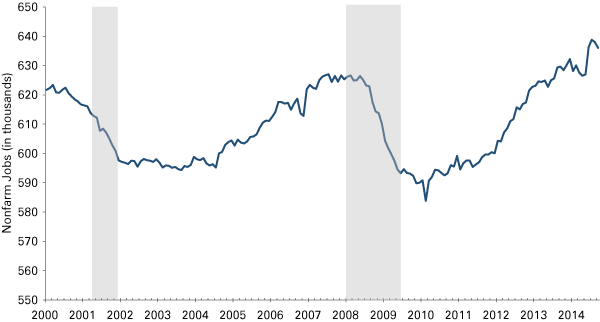
Note: Shaded regions indicate recessions.
Source: Factset
Manufacturing payrolls showed continued deceleration from the high growth observed over 2012, but are now on an upswing. Additionally, leisure and hospitality and education and health services showed steady gains through all of 2014. Unfortunately, metro area retail employment showed steady declines through all of 2014. The financial activities sector also saw a decline in payrolls, shedding some of the jobs gained through 2013. Specialty trade contractors, while showing some improvement from earlier in the year, continued to see a reduction in payrolls (see Figure 2).
Figure 2: Year-over-Year Percent Change in Payroll Jobs for Selected Louisville Metro Sectors, October 2004 to September 2014
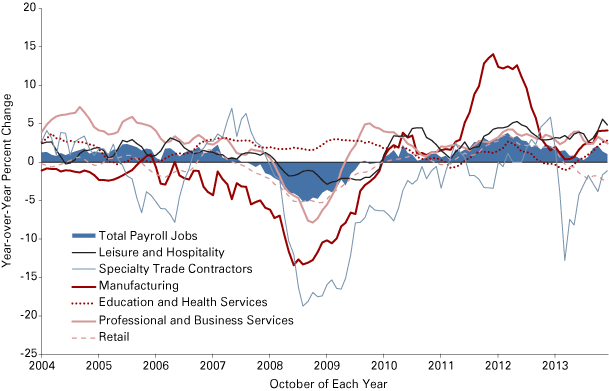
Source: Factset
Southern Indiana Payrolls
Southern Indiana continued to observe steady growth in payroll (see Figure 3).
Figure 3: Change in Southern Indiana Payroll Jobs for Selected Sectors
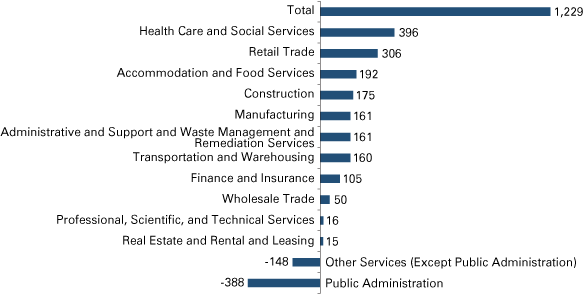
Note: This year-over-year change compares 2014 Q1 to 2013 Q1.
Source: STATS Indiana, using Quarterly Census of Employment and Wages data
First quarter 2014 did see slower gains compared to the previous year (due to the nation’s slower first quarter economy), as shown in Figure 4.
Figure 4: Change in Southern Indiana Payroll Jobs over Time
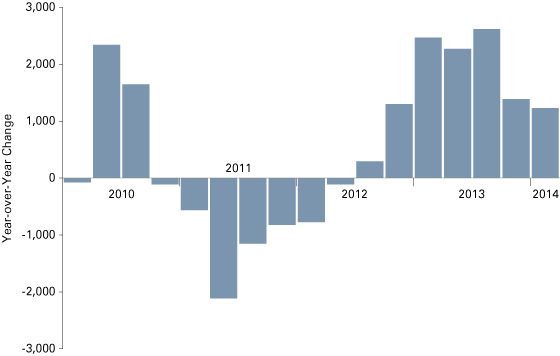
Source: STATS Indiana, using Quarterly Census of Employment and Wages data
While Southern Indiana as a whole saw respectable payroll growth, this growth was uneven across the counties, with a significant component of this growth occurring primarily in Clark County. Health care and social services contributed the most to overall payroll growth, followed by retail and accommodation and food services. The downside to this growth is that retail and accommodation and food services are among the lowest paid industries, thus placing additional pressures on overall personal income growth for the region.
Recent labor force data for Indiana indicate that employment continues to increase from the previous year, an early indicator of steady payroll growth throughout 2014. Payroll growth for 2015 should remain strong in Southern Indiana as the region continues to see payroll growth in the River Ridge commercial area and the bridges project nears completion.
Unemployment Rates
Gains to the Southern Indiana economy are also evident through improvements to county unemployment rates (see Figure 5). In all metro Southern Indiana counties, unemployment rates are under 6 percent. Likewise, the most recent Louisville metro unemployment rate stands at 5.5 percent.
Figure 5: September Unemployment Rates for Selected Southern Indiana Counties
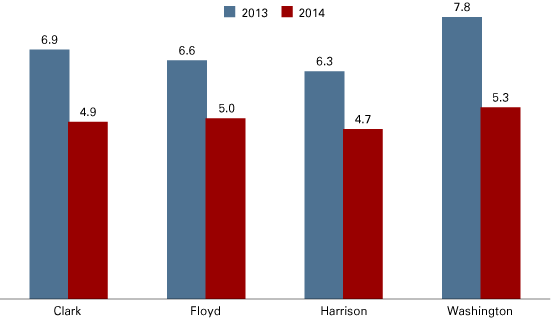
Source: STATS Indiana, using Local Area Unemployment Statistics data
Building Permits
Building permits continue to show gains from the depths of the recession, but remain a fraction of the levels observed leading to the recession. In Southern Indiana, a significant piece of this permit growth occurred in Clark County alone. Permit growth should continue through all of 2015 and exceed levels observed in 2014.
Figure 6: Total Building Permits for Selected Southern Indiana Counties
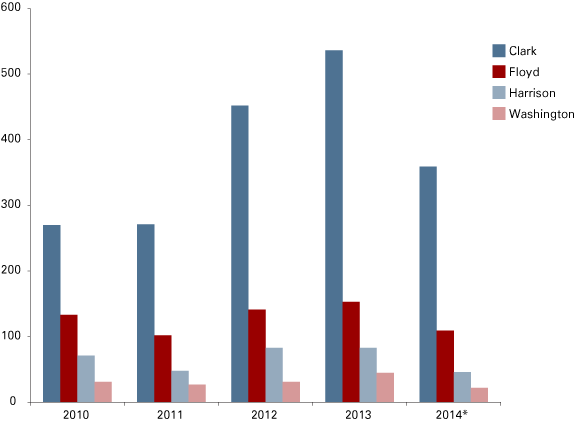
* 2014 data are August year to date.
Source: State of the Cities Data Systems
2015 Outlook
The payroll gains expected in 2014 have yet to materialize. Despite relatively moderate payroll growth nationally, these gains were not evident at the Louisville metro level. Moving forward, the entire metro region will see an improvement from 2014. The continuing national recovery will trigger additional gains in manufacturing, which will support overall growth for Southern Indiana and the Louisville metro. Data in late 2014 are already pointing to a resumption of this growth in manufacturing.
Preliminary third-quarter U.S. GDP data show strong growth, and this robust national growth will be evident through an acceleration of local payrolls. This is already reflected in some of the data, and we can expect this stronger national demand to impact local sectors. Wild cards certainly do remain, and as with the case of the harsh winter of 2014, external shocks can always detract from this growth. Louisville is not immune to events that occur on the world stage.
Overall, 2015 payroll growth will certainly exceed payroll growth of 2014. Key to this growth, however, is the types of jobs that will support discretionary consumer spending and stronger household income growth.




